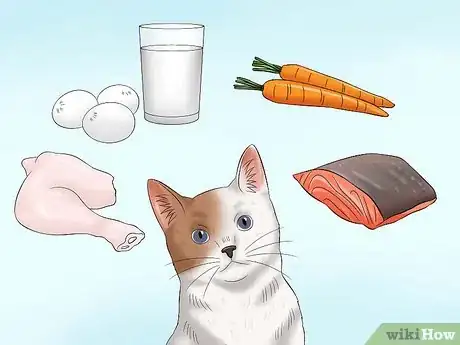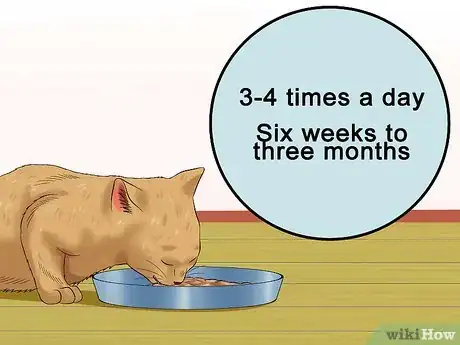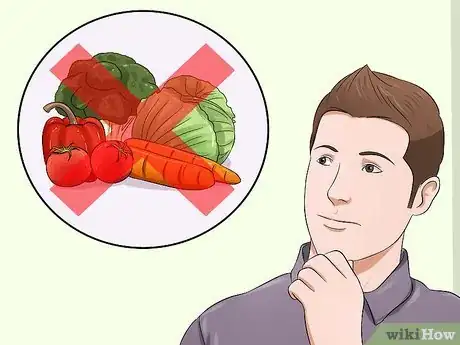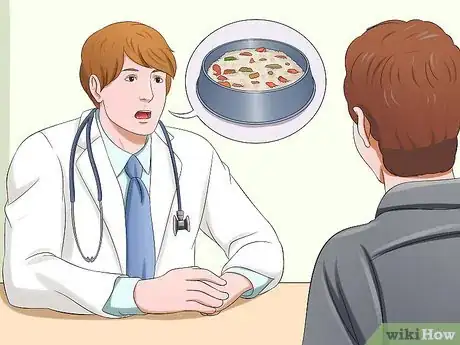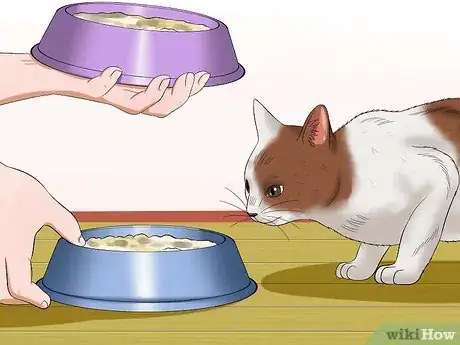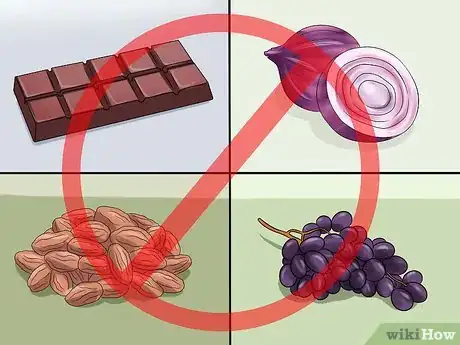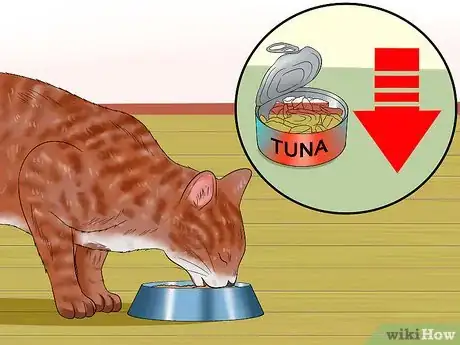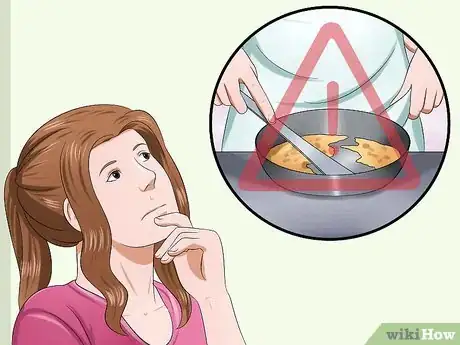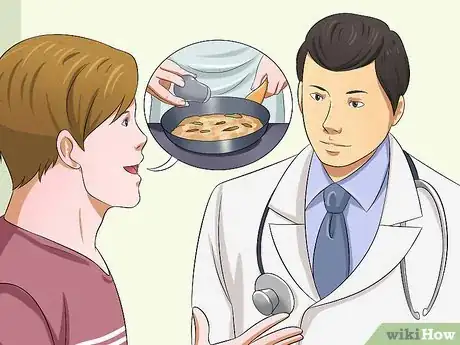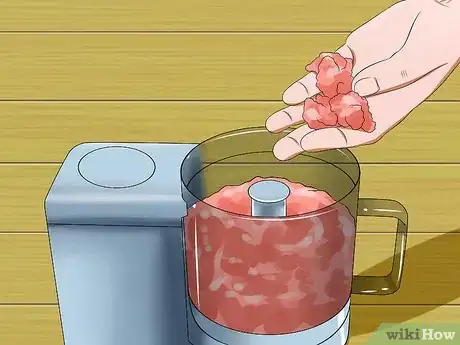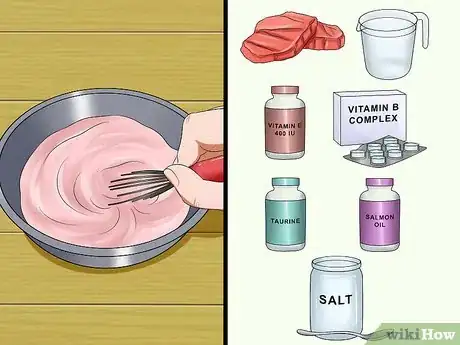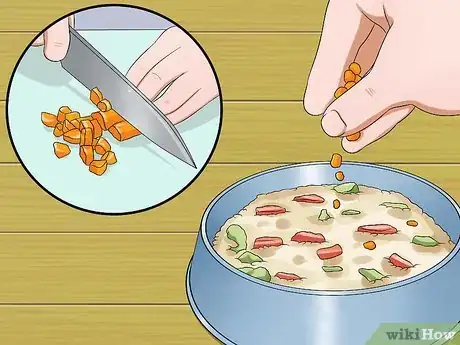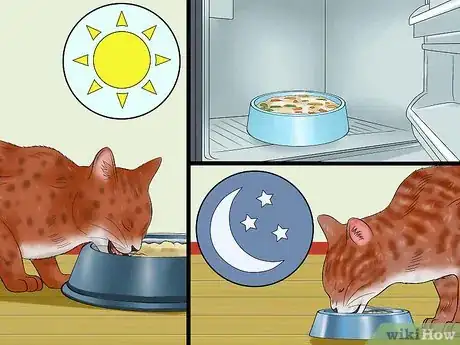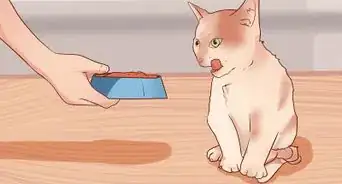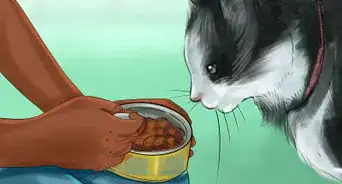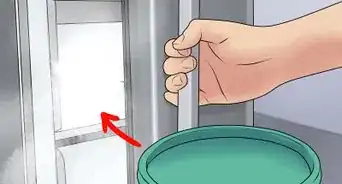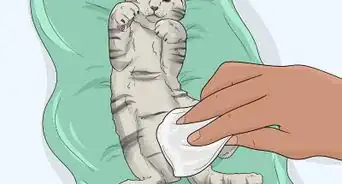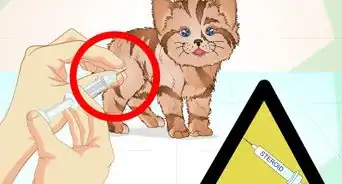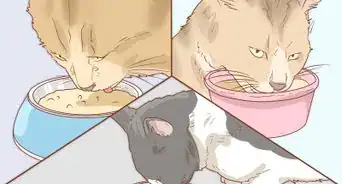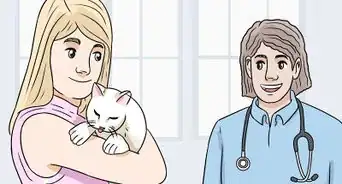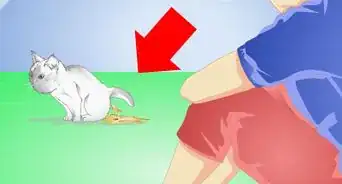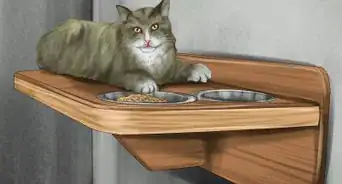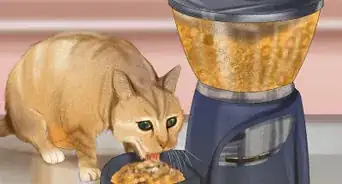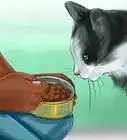This article was co-authored by Pippa Elliott, MRCVS. Dr. Elliott, BVMS, MRCVS is a veterinarian with over 30 years of experience in veterinary surgery and companion animal practice. She graduated from the University of Glasgow in 1987 with a degree in veterinary medicine and surgery. She has worked at the same animal clinic in her hometown for over 20 years.
There are 8 references cited in this article, which can be found at the bottom of the page.
wikiHow marks an article as reader-approved once it receives enough positive feedback. In this case, 95% of readers who voted found the article helpful, earning it our reader-approved status.
This article has been viewed 463,149 times.
As carnivores, cats need to eat meat and avoid eating unhealthy foods full of indigestible carbohydrates. Feeding cats the wrong diet can cause health problems and ultimately lessen the length of their lives. Cooking for cats can be a great way to get your cats the proteins they need, and it can also be a very enjoyable pastime for the people making it. It's essential to consult with a qualified veterinary nutritionist before embarking on feeding you cat solely on home prepared foods
Steps
Understanding a Cat's Dietary Needs
-
1Be familiar with the dietary requirements of cats. Cats have nutritional requirements that are vastly different from our own, requiring careful consideration and planning of the food they're receiving. Cats need a diet high in protein and fat. In fact, cats need twice the amount of protein that dogs need.[1] Do not attempt to do this on your own — talk with your cat's veterinarian about getting a referral to a qualified veterinary nutritionist who can ensure your cat will be getting all the necessary nutrients.
- Cats need approximately 85 percent meat, fat, offal, and bone in their diet, with vegetables, herbs, and roughage making up only 15 percent of feline dietary requirements.[2]
- Formulating a correctly balanced diet is very difficult and something even veterinary nutritionists struggle with. If you get it wrong, the cat won't show signs for days and weeks, but problems develop months or years down the line. Don't change your cat's diet without consulting a nutritionist and allow yourself to have a false sense of security that your cat seems fine and healthy.
-
2Identify all the parts of a healthy cat diet. A healthy diet for a cat will ensure the following:[3] clean water (available at all times and easily accessible), protein (most cats won't eat food containing less than 20 percent protein), fat (cats need fat for energy, essential fatty acids, fat-soluble vitamin intake, and taste), vitamin A (cats need a good dose of this vitamin. It is found in liver, eggs, and milk but these ingredients need to be used with caution), vitamin B (Cats need vitamin B and will readily eat brewer's yeast if there are signs of deficiency, such as loss of appetite for a few days or a fever), vitamin E (Vitamin E is needed to break down unsaturated fats in the cat's diet), and calcium (This is an important part of building and maintaining your cat's bones).
- Taurine is an amino acid that is also essential to a cat's diet. Sufficient amounts of taurine usually exist in commercial cat foods (both dry and wet), but your cat may be at risk of a taurine deficiency if you feed it homemade foods or a vegetarian diet. Taurine deficiency in felines can cause central retinal degeneration, leading to irreversible blindness, as well as heart failure. This is why adding taurine to your cat's diet is crucial.
Advertisement -
3Think about when and how your cat should be fed. For instance, cats in different stages of life may need different feeding schedules or types of food. While most cats can regulate their food intake fairly well, there are some cases where you will need to regulate it for them.
- Kittens need to be fed three to four times a day from the ages of six weeks to three months. By six months of age, feeding can be reduced to twice daily.
- Adult cats should be allowed to eat when they want, grazing throughout the day, but if that is impossible, they should be fed at least several times each day.
- If you have multiple cats that have different diets, you may need to figure out a feeding system that keeps them out of each other's food.
-
4Consider your cats health over your personal dietary regime. Cats cannot thrive (or survive) on a vegetarian diet.[4] [5] It is recognized that there is intense debate and passion on this topic but placing the cat's natural needs first is a primary concern of cat well-being.
- While there are specific supplements some vegetarians feed to their cats, such as taurine, and numerous suggestions for vegetarian cat diets, a vegetarian diet for a cat can result in blindness and heart failure. Not only is this type of diet a highly intensive effort for an owner, it risks a shortened lifespan and diseases, especially if it introduces a higher level of unhealthy carbohydrate products into the cat's diet.
-
5Consult a your vet and a qualified veterinary nutritionist and do research before you begin cooking for your cat. A fully home prepared diet with no quality brand name commercial foods included requires careful balancing to ensure that your cat is getting everything it needs. It is not recommended unless you have thoroughly researched what your cat needs and have raised the matter with your vet.
-
6Be aware that cats are easily addicted to eating a certain way. If you haven't already noticed this, it can be frustrating to try to change your cat's diet. Don't be surprised if your cooking efforts are rebuffed! Persevere and keep trying until you pique your cat's curiosity. Removing your cat's usual food on the occasion of trialing the new food is an important part of encouraging her to give a new food a go.
- Try gradually adding your homemade food to your cat's usual food. This will acclimate them to the new textures and smells of a homemade diet.
- Don't leave uneaten food out. If your cat hasn't eaten it within the hour, dispose of it. Just try again another time.
-
7Avoid giving your cat foods that are dangerous or toxic to them. Remember that just because you can eat it, doesn't mean your cat can. Foods not to give your cat include onions, garlic, chives, grapes, raisins, chocolate (even white chocolate), sugar, uncooked yeast dough, and spices from your pantry such as nutmeg, baking powder, and baking soda.[6]
- Other ingredients to avoid include alcohol (it has the same impact as on humans only much faster — just two teaspoons of whiskey can induce a coma in a 5-pound cat), dog food (wet or dry — dog food has completely different nutrient content), candy and gum (if sweetened with xylitol, this can cause liver failure), coffee, tea, and other caffeinated products such as cold medicines, stimulant drinks and painkillers (large quantities can kill a cat and there is no antidote), and human medication of any kind (acetaminophen and ibuprofen can be deadly to cats).[7]
-
8Limit foods that are not toxic to cats but are not good for them in large amounts. Cats need a well rounded diet but that does not mean that they need all nutrients in large amounts.
- Limit fat trimmings and bones. Cooked bones should not be fed to cats and fat can cause pancreatitis in cats.[8]
- If you want to feed your cat raw eggs, only give them the yolk. Cook the egg whole if also using the white. Consider cooking the whole egg each time, as raw eggs can carry Salmonella. Even if they don't get sick, the cat can be a subclinical carrier of Salmonella, basically meaning that it can be transferred from cats to human beings.[9]
- Raw meat should be frozen prior to feeding unless you are absolutely sure of its healthy origins.
- Feed your cat liver no more than twice weekly.
- Tuna can be addictive if overfed and result in a thiamine deficiency. Basically too much of the diet devoted to any kind of fish can also result in such deficiency.
- Milk and milk products can upset many cats, including digestion and itchiness. Talk to your vet if you'd like to continue using it; not every vet or cat owner is convinced that milk is inappropriate for cats able to tolerate it.
-
9Be very cautious before seeking to cook for your cats as a permanent feeding strategy. Unless you're absolutely certain that you're getting the balance right, cooking all of your cat's diet at home can result in deficiencies and harm your cat. Many vets won't recommend a home-cooked diet for pets simply because they know most people don't have the training or knowledge to do so, and that busy owners may stray from fulfilling recommended recipes aimed at providing optimal nutrition due to time constraints.[10] In addition, vets may have concerns about the lack of sufficient knowledge about dietary needs, and lapses of attention to the diet caused by human life events.[11]
- If you're eager to cook for your cats all the time, it is doable, it just requires a lot of (often conflicting) research and weighing up of the options of what's available in your area.
- Consider your lifestyle. If you travel a lot and have other people feeding your cats, are you going to be able to ensure that their home-cooked diet is adequate? If you work long hours, are you prepared to make up batches of food each weekend to be feed throughout the week?
- Some people favor feeding raw foods. This is controversial for a number of reasons, including an increased risk of infection from parasites and bacteria that are now not killed by cooking. A raw diet is currently not recommended by veterinary bodies such as the American Veterinary Medical Association (AVMA) because the risks outweigh the benefits.
Making Your Own Cat Food
-
1Remember that you need to get, or create, a recipe that gives your cat well-balanced nutrition. Getting the recipe wrong, or having a recipe that is lacking in essential nutrients, could cause severe health problems in your cat. Just as in other animals, including humans, the key is a healthy balance. Even essential nutrients can negatively affect your cat's health if you give them too much.
- Because the balance of nutrients is so important, you should get input about your recipe from your veterinarian or an expert on cat health, even if the recipe was formulated by someone else.
-
2Formulate or find a recipe and start cooking. Once you've got the basics of feline dietary needs, you're ready to start cooking for your cats. Note that the following ideas are suggested recipes for occasional variety and do not represent a diet plan. If you wish to cook or make homemade cat food as a permanent dietary change for your cat, it's important to do your research to create a balanced diet that meets all of your cat's needs, and to get your vet's stamp of approval.
- Your cat may not like homemade food but it will let you know soon enough!
- If you have any concerns, talk to your vet about the appropriateness of cooking food for your cat, especially if your cat is growing, pregnant, unwell, or has medical conditions.
-
3Begin with protein. For instance, purchase free-range, antibiotic and hormone-free whole chicken thighs from a reputable source. You can also use chicken livers, turkey, and egg yolks, among other options.
- Make sure you fully cook the meat to destroy any bacteria. Then remove some of the meat from the bone and cut into chunks of around 1⁄2 inch (1.3 cm) (12.7mm) using sharp kitchen scissors or a knife.
-
4Grind the animal protein to make it easier to eat. Place meaty bones into a meat grinder with a grinding plate of .15 inch (0.38 cm) (4mm) holes. Run 4 oz of chicken livers per 3 pounds (1.3kg) of raw chicken meat through the grinder. Run 2 cooked eggs per every 3 pounds (1.3kg) of raw chicken meat through the grinder. Mix everything together in a bowl and refrigerate.
- If you don't own a grinder, you can use a food processor instead. It will not be as efficient or as easy to clean but it will cut the protein into small, digestible pieces.
-
5Mix additional ingredients. In a separate bowl, for every 3 pounds (1.3kg) of meat, pour in 1 cup water, 400 IU (268 mg) vitamin E, 50 mg vitamin B-complex, 2,000 mg taurine, 2000 mg wild salmon oil, and 3/4 tsp light salt (with iodine). Mix all ingredients together.
- Pour the supplement mix into the ground meat and mix well.
-
6Consider a variety of other foods that can give your cat important nutrients. These ingredients should not form the majority of your cat's meals, in fact they shouldn't be a part of every meal, they can add key nourishment for your cat.
- Mix a little steamed rice with some chopped salmon and a little bit of water. The consistency will be soup-like; simply pour into your cat's bowl.
- Cut vegetables into small pieces and add to the meal (the type of vegetables are up to you).
- Add oats to your cat's food. Bring 8 cups of water to a boil. Follow the directions on the package of oats for water to oats ratio. Add the oats and cover. Then turn off the heat, letting oats cook for 10 minutes until soft.
- Some other suggestions include: An oat based raw cat food meal, tuna cat treats, and holistic cat food recipes for whole health.
-
7Make meal sized portions and freeze. The average cat eats about 4 - 6 ounces a day. Keep your cat's meals in the freezer until the night before you plan on feeding it to them and at which point you should move it into the fridge. This will give the food enough time to defrost.
Expert Q&A
Did you know you can get expert answers for this article?
Unlock expert answers by supporting wikiHow
-
QuestionMy older cat has hyperthyroidism. He has been getting organic chicken livers twice a week. Is this still ok?
 Pippa Elliott, MRCVSDr. Elliott, BVMS, MRCVS is a veterinarian with over 30 years of experience in veterinary surgery and companion animal practice. She graduated from the University of Glasgow in 1987 with a degree in veterinary medicine and surgery. She has worked at the same animal clinic in her hometown for over 20 years.
Pippa Elliott, MRCVSDr. Elliott, BVMS, MRCVS is a veterinarian with over 30 years of experience in veterinary surgery and companion animal practice. She graduated from the University of Glasgow in 1987 with a degree in veterinary medicine and surgery. She has worked at the same animal clinic in her hometown for over 20 years.
Veterinarian
-
QuestionIs cooking for a cat healthier than feeding regular dry food?
 Pippa Elliott, MRCVSDr. Elliott, BVMS, MRCVS is a veterinarian with over 30 years of experience in veterinary surgery and companion animal practice. She graduated from the University of Glasgow in 1987 with a degree in veterinary medicine and surgery. She has worked at the same animal clinic in her hometown for over 20 years.
Pippa Elliott, MRCVSDr. Elliott, BVMS, MRCVS is a veterinarian with over 30 years of experience in veterinary surgery and companion animal practice. She graduated from the University of Glasgow in 1987 with a degree in veterinary medicine and surgery. She has worked at the same animal clinic in her hometown for over 20 years.
Veterinarian The difficulties of creating a balanced diet for cats are greatly underestimated. The problem being that dietary deficiencies don't show for weeks, months, or even years... but in the end they will cause problems such as weak bones that are prone to fractures, heart disease, or blindness. The crucial thing when feeding dry food is to encourage the cat to drink plenty, and if you do decide to change diet, do so under the guidance of a veterinary nutritionist.
The difficulties of creating a balanced diet for cats are greatly underestimated. The problem being that dietary deficiencies don't show for weeks, months, or even years... but in the end they will cause problems such as weak bones that are prone to fractures, heart disease, or blindness. The crucial thing when feeding dry food is to encourage the cat to drink plenty, and if you do decide to change diet, do so under the guidance of a veterinary nutritionist.
Warnings
- Milk contains lactose and cats don't have the lactose-splitting enzyme lactase. Because of this, milk can lead to diarrhea for some cats and kittens. However, not all cats react in this way and may be fine with milk. It does serve as a source of calcium if your cat enjoys it and doesn't suffer from side effects but it can lead to itchiness and inability to digest. It's wise to discuss this with your vet.⧼thumbs_response⧽
- Ideas about feeding our pets continue to change as more veterinary research is released. Update your knowledge continuously.⧼thumbs_response⧽
References
- ↑ Dr Julie Summerfield, Cat Talk: With Scooter, p. 118, (2004), ISBN1-876624-81-7
- ↑ Dr Clare Middle, Real Food for Dogs and Cats, p. 116, (2008), ISBN 978-1-92136135-7
- ↑ Dr Peter Roach, Pet Care Book, p. 86, (undated)
- ↑ Dr Clare Middle, Real Food for Dogs and Cats, p. 116, (2008), ISBN 978-1-92136135-7
- ↑ Dr Julie Summerfield, Cat Talk: With Scooter, p. 118, (2004), ISBN1-876624-81-7
- ↑ http://pets.webmd.com/cats/slideshow-foods-your-cat-should-never-eat
- ↑ http://pets.webmd.com/cats/slideshow-foods-your-cat-should-never-eat
- ↑ http://pets.webmd.com/cats/slideshow-foods-your-cat-should-never-eat
- ↑ http://www.cat-world.com.au/salmonellosis-in-cats
- ↑ Lisa A Pierson, DVM, Making cat food, http://www.catinfo.org/?link=makingcatfood
- ↑ Lisa A Pierson, DVM, Making cat food, http://www.catinfo.org/?link=makingcatfood
- ↑ Dr Clare Middle, Real Food for Dogs and Cats, pp. 116-118, (2008), ISBN 978-1-92136135-7
- ↑ Dr Clare Middle, Real Food for Dogs and Cats, pp. 116-118, (2008), ISBN 978-1-92136135-7
About This Article
To cook for you cat, use high protein foods, like chicken thighs, chicken livers, or turkey, as the main basis of your recipe, since cats need to eat a diet that’s mostly protein. However, make sure to limit fat trimmings, which can cause pancreatitis, and avoid foods that are toxic to cats, such as onions, chives, and raisins. Additionally, cook for your cat as a way to supplement its diet rather than as a permanent feeding strategy to ensure your cat is getting all the nutrients it needs. For example, try giving your cat a home-cooked meal twice a week as a special treat. For more advice from our Veterinary co-author, like how to make and store your own batches of cat food, keep reading

